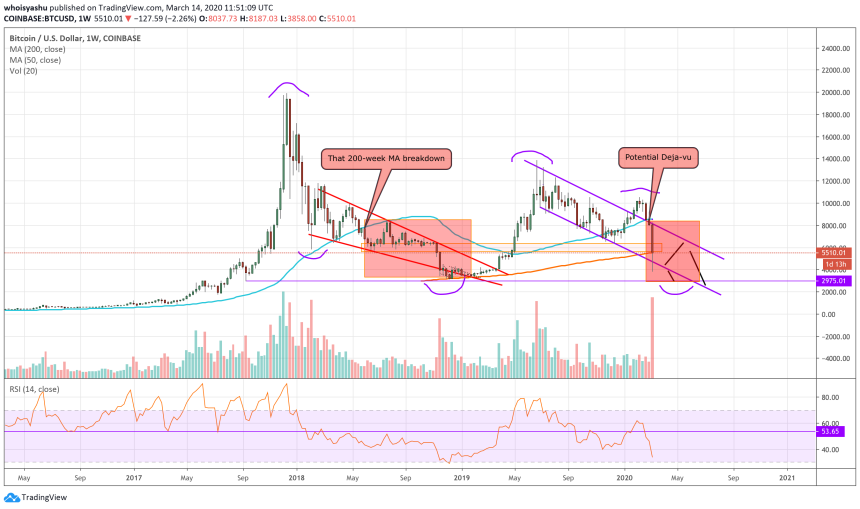Reason to trust

How Our News is Made
Strict editorial policy that focuses on accuracy, relevance, and impartiality
Ad discliamer
Morbi pretium leo et nisl aliquam mollis. Quisque arcu lorem, ultricies quis pellentesque nec, ullamcorper eu odio.
Bitcoin logged its wildest week for the first time in seven years, plunging by more than 50 percent after a sell-off sparked by the worsening Coronavirus pandemic.
The benchmark cryptocurrency on Friday crashed from $8,187 to $3,858 with a matter of 30 minutes. A rebound ensued and took prices up to $5,995. Traders ignored putting bullish positions beyond $6,000, a psychological resistance, which caused a pullback of more than $500 on Saturday.
Failure to break above $6,000 had analysts make serious warnings about bitcoin’s imminent future. Prominent analyst Tone Vays noted that the cryptocurrency could plunge below $5,000 once again, without giving away details of when and how. Veteran trader Peter Brandt, on the other hand, went a step ahead and predicted the potential of a $1,000 bitcoin.
If I interpret the chart without bias, I would say sub $1,000
— Peter Brandt (@PeterLBrandt) March 12, 2020
For better or worse, these warnings make sense, given how bitcoin has reacted to the Coronavirus epidemic so far. And now, a convincing fractal is showing a similar picture for the world’s leading cryptocurrency, stating that its price could crash towards $2,900 in coming sessions.
That 50-Week Moving Average
On March 2, the bitcoin-to-dollar exchange rate fell below its 50-week moving average, a bias-indicating wave since the inception of bitcoin trading.
Historically, breaking below the technical parameter has not brought any good news for the cryptocurrency. When the price broke below the wave on May 21, 2018, it crashed by about 62 percent – from $8,488 to about $3,120, in seven months.

The breakdown was just not technical but had adequate market catalysts pushing the price down. In November 2018, bitcoin broke below $6,000 mainly because of the Bitcoin Cash hardfork. The notorious event saw a civil war-like situation between the two opposing groups inside the Bitcoin Cash community, leading to a chain split that would give birth to Bitcoin SV.
Both Bitcoin Cash and Bitcoin SV threatened to dump their bitcoin holdings to generate capital for mining their respective blockchains. Hence, the price crashed, partially preserving the 200-week breakdown sentiment.
Jihan:
I have no intention to start a hash war with CSW, because if I do (by relocating hash power from btc mining to bch mining), btc price will dump below yearly support; it may even breach $5000. But since CSW is relentless, I am all in to fight till death! pic.twitter.com/d95axXEwFS
— RamenPanda (@IamRamenPanda) November 14, 2018
Cut to today, Coronavirus has replaced “hash war” as the new bearish catalyst. Meanwhile, the 200-week moving average stands broken to the downside, giving bitcoin enough room to continue its plunge –maybe by 62 percent as the last time.
Lower Low Formation in Larger Setting
As bearish fundamentals marry technicals, bitcoin’s next downside target looks to be near $2,900. That’s about $300 below the previous bottom formation in December 2018, giving away a lower-low vibe amid a broader downtrend, as shown via roughly made tops and floors in the chart above.
The prediction falls right in the middle of what Peter Brandt and Tone Vays suggested. Should Coronavirus clusters get any bigger in the United States and other parts of the world, it would serve as a go-to indicator for investors to exit their positions for assets that matter in real-life: cash, food, water, sanitizers, and lots of toiler papers.
At the same time, signs of Coronavirus slowdown and the development of vaccines to battle it could ease the pressure off bitcoin, gold, and stock markets in unison.






















